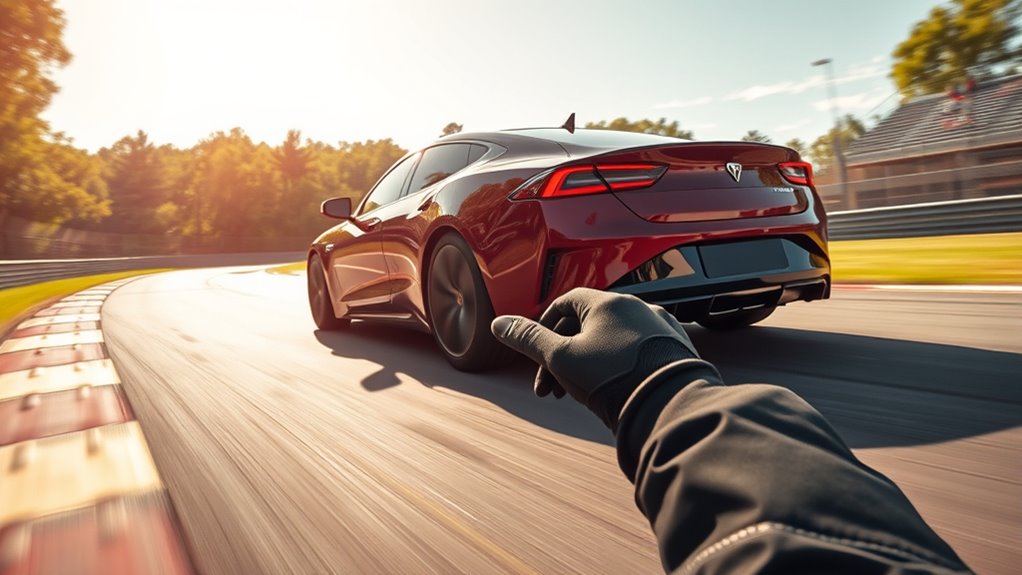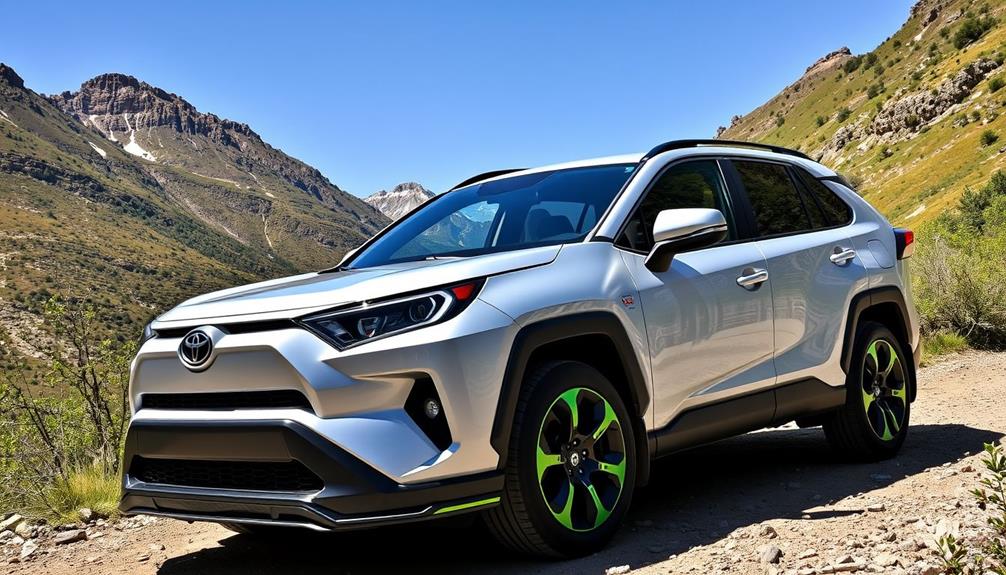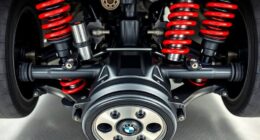To boost lap times with regenerative braking, focus on smooth, controlled deceleration rather than harsh stops. Ease off the accelerator early to engage energy recovery and anticipate corners to coast efficiently. Use engine braking where possible to preserve momentum and minimize brake fade. Stay mindful of proper brake modulation and keep your system well-maintained for maximum performance. Mastering these techniques will open faster, smoother laps—keep going to discover even more tips to refine your driving.
Key Takeaways
- Anticipate braking points early to smoothly engage regenerative braking and maximize energy recovery.
- Use gentle, controlled deceleration rather than abrupt stops to optimize energy capture.
- Lift off the throttle early to naturally switch into regenerative mode and reduce brake wear.
- Maintain proper brake modulation and keep brake systems clean for consistent, efficient deceleration.
- Focus on smooth driving rhythm and mindfulness to enhance overall braking efficiency and lap times.

Regenerative braking is a clever way to recover energy when you slow down, but you can maximize its benefits with a few simple hacks. By optimizing your braking technique and understanding how to leverage brake efficiency, you’ll boost your energy recovery and shave seconds off your lap times. The key lies in gentle, controlled deceleration rather than abrupt stops. When you ease off the accelerator early, your hybrid’s regenerative system kicks in sooner, capturing more kinetic energy and converting it into electrical power. This not only conserves energy but also reduces brake wear, allowing the system to operate at peak efficiency.
To improve your energy recovery, try to anticipate corners and braking points well in advance. Instead of slamming the brakes at the last second, gradually ease into deceleration. This smooth approach enhances brake efficiency because the system can engage more effectively during steady, moderate braking rather than abrupt stops. It also prevents sudden weight shifts that can destabilize your car, maintaining better control through corners. The more consistent your braking, the more energy you recover, which translates into better overall performance on the track.
Anticipate braking points early for smoother, more efficient energy recovery on the track.
Another hack is to utilize engine braking whenever possible. When you lift off the throttle early, your hybrid system switches into regenerative mode automatically. This technique allows you to slow down without stepping heavily on the brake pedal, maximizing energy recovery without sacrificing brake efficiency. It also helps you maintain a smoother driving rhythm, which is essential for faster lap times. By combining gentle engine braking with strategic braking during tight corners, you preserve momentum while still capturing valuable energy.
Additionally, adjust your driving style to favor regenerative braking. Avoid aggressive braking unless absolutely necessary, and instead, focus on early, light deceleration. This approach not only improves energy recovery but also reduces brake fade, ensuring consistent brake efficiency throughout your session. Coupling this with proper brake modulation helps you maintain peak brake system performance, vital for consistent lap times. Remember, the goal isn’t just to slow down but to do so in a way that recovers energy efficiently while maintaining control and speed.
Finally, keep your brake system well-maintained and check the regenerative components regularly. A clean, responsive brake setup ensures maximum brake efficiency, allowing you to recover the most energy possible during each slowdown. When your brakes are in top shape, you can decelerate smoothly and consistently, which is essential for quick laps. Additionally, understanding how spirituality and mindfulness can enhance your connection to the Vortex can help you stay focused and present during high-pressure driving situations. By combining these hacks—anticipating braking points, smoothing deceleration, utilizing engine braking, and maintaining your brakes—you’ll unlock the full potential of regenerative braking, helping you go faster and more efficiently on the track.
Frequently Asked Questions
How Does Regenerative Braking Affect Tire Wear?
Regenerative braking can influence tire wear by affecting brake balance and tire pressure. When you rely on regenerative braking, you might notice uneven tire wear if the brake balance isn’t properly adjusted, as more stress shifts to certain tires. Maintaining correct tire pressure guarantees even contact with the road, reducing unnecessary tire wear. Properly balancing regenerative braking and regular tire checks help optimize performance and extend tire life.
Can Regenerative Braking Be Customized for Different Driving Styles?
You can definitely customize regenerative braking to suit your driving style through adaptive braking systems. These systems adjust how much energy is recovered based on your habits, whether you prefer a more aggressive or smooth approach. Driver customization options let you fine-tune regenerative braking intensity, helping you optimize energy recovery and braking feel. This way, you enhance your driving experience and efficiency, making your hybrid car better suited to your unique style.
What Are the Potential Drawbacks of Aggressive Regenerative Braking?
Aggressive regenerative braking can boost energy recovery efficiency, but it also has drawbacks. You might experience increased battery degradation over time due to frequent high-power charging cycles. Additionally, too much braking force can make your driving feel less smooth and harder to control, especially in tight corners. While it helps save energy, pushing regenerative braking too hard can compromise battery life and overall vehicle reliability, so balance is key.
How Does Ambient Temperature Influence Regenerative Braking Efficiency?
Ambient temperature considerably influences regenerative braking efficiency. When it’s chilly, the thermal impact reduces battery performance, causing energy loss and less effective energy recovery. Conversely, warm temperatures optimize the thermal environment, boosting battery responsiveness and maximizing energy retention. You’ll notice smoother, more efficient braking in moderate conditions, while extreme cold hampers regenerative capabilities. Adjusting your driving in line with temperature can help you harness more energy and enhance your hybrid car’s overall performance.
Is Regenerative Braking Effective at Very High or Very Low Speeds?
At very high speeds, regenerative braking becomes less effective because the system struggles to convert all the kinetic energy quickly, reducing high speed efficiency. Conversely, at low speeds, it excels in energy recovery, allowing you to maximize braking energy and improve overall efficiency. You’ll find regenerative braking works best during moderate to low speeds, helping you recover more energy during deceleration and boosting your hybrid car’s performance on the track.
Conclusion
Think of regenerative braking as your car’s secret treasure chest, quietly collecting energy with every slow down. By mastering these hacks, you’re like a skilled pirate, revealing hidden riches on each lap. When you harness this power wisely, your hybrid car becomes a swift vessel, sailing faster around corners and down straights. Embrace these tricks, and you’ll find yourself steering the racecourse like a legendary explorer, turning every brake into a boost toward victory.










